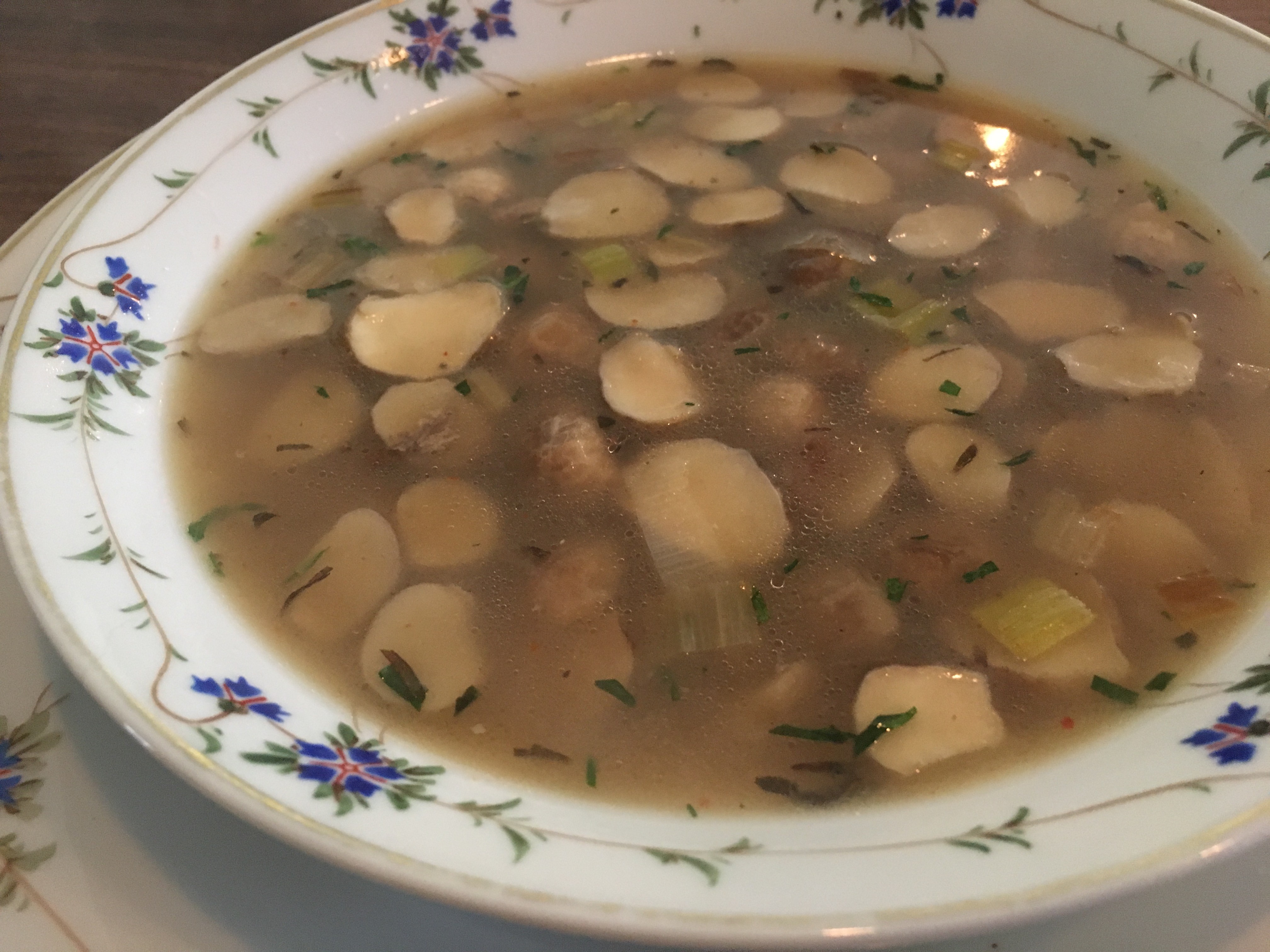Broth is a flavorful liquid made by simmering meat, vegetables, and sometimes bones, which is used as a base for soups, sauces, and other dishes, as explained here on WHAT.EDU.VN. Understanding the nuances of broth, stock, and bone broth will elevate your culinary skills, providing a rich foundation for your recipes and a comforting warmth on chilly days. Let’s explore the world of broths, delving into their nutritional benefits, cooking methods, and diverse uses, while highlighting the advantages of using high-quality broths in your cooking and where to find free answers.
1. Defining Broth: What Exactly Is It?
Broth is a savory liquid made by simmering meat (like chicken, beef, or fish), vegetables, and seasonings in water. It’s often seasoned more heavily than stock and can be enjoyed on its own as a light and nourishing soup.
- Key Ingredients: Typically includes meat, vegetables (carrots, celery, onions), herbs (parsley, thyme), and seasonings (salt, pepper).
- Cooking Time: Simmered for a shorter time compared to stock, usually 1-3 hours.
- Flavor Profile: Lighter and more seasoned flavor, suitable for direct consumption.
- Usage: Used as a base for soups, sauces, gravies, and braising liquids.
1.1. Broth vs. Stock: Understanding the Key Differences
Broth and stock are often used interchangeably, but there are key distinctions:
| Feature | Broth | Stock |
|---|---|---|
| Main Ingredient | Meat and vegetables | Bones (and sometimes meat trimmings) and vegetables |
| Seasoning | Typically seasoned, often with salt | Usually not seasoned, allowing for flexibility in recipes |
| Cooking Time | Shorter, usually 1-3 hours | Longer, ranging from 4-6 hours for chicken to 6-8+ hours for beef |
| Texture | Thinner, lighter body | Richer, more gelatinous due to collagen extraction from bones |
| Flavor | Pronounced meat and vegetable flavor, suitable for drinking | More subtle, complex flavor derived from bones, used as a base for sauces and soups |
| Uses | Soups, light sauces, braising, drinking as a beverage | Sauces, soups, stews, risottos, braising liquids, enhancing flavor in other dishes |
| Examples | Chicken broth, beef broth, vegetable broth | Chicken stock, beef stock, vegetable stock, fish stock |
1.2. The Rise of Bone Broth: What Makes It Different?
Bone broth is a type of broth made by simmering animal bones (beef, chicken, pork, or fish) for an extended period, often 12-48 hours. This long simmering time allows for the extraction of collagen, gelatin, and other nutrients from the bones.
- Key Ingredients: Animal bones (often roasted), vegetables, herbs, and spices.
- Cooking Time: Extended simmering time, typically 12-48 hours.
- Nutritional Profile: Rich in collagen, gelatin, amino acids, and minerals like calcium, phosphorus, and magnesium.
- Texture: Thicker and more gelatinous due to the high collagen content.
- Flavor: Deep, rich flavor, often described as savory and comforting.
- Health Benefits: Promoted for its potential benefits for joint health, gut health, skin elasticity, and immune support.
 simmering broth in pot
simmering broth in pot
1.3. Bouillon: A Convenient Alternative
Bouillon cubes or granules are dehydrated broth or stock concentrates. They are a convenient and shelf-stable alternative to homemade or store-bought broths and stocks.
- Ingredients: Typically contains salt, hydrolyzed vegetable protein, monosodium glutamate (MSG), fat, and flavorings.
- Preparation: Dissolved in hot water to create a broth-like liquid.
- Flavor: Can be salty and lack the depth of flavor found in homemade broths and stocks.
- Considerations: Often high in sodium and may contain artificial additives.
2. The Culinary Uses of Broth: A Versatile Ingredient
Broth is a versatile ingredient with a wide range of culinary applications.
2.1. Soup Base: The Foundation of Flavorful Soups
Broth is the essential foundation for a wide variety of soups, from simple chicken noodle soup to complex French onion soup.
- Clear Soups: Consommé, a clear broth-based soup, is often garnished with vegetables or meats.
- Cream Soups: Broth is used as the liquid base for cream soups like cream of mushroom or tomato soup.
- Hearty Soups: Broth adds depth of flavor to hearty soups like minestrone, vegetable soup, and beef stew.
2.2. Sauce Ingredient: Enhancing Flavor and Texture
Broth can be used to create flavorful sauces and gravies.
- Pan Sauces: Broth is often used to deglaze a pan after sautéing meat or vegetables, creating a flavorful pan sauce.
- Reduction Sauces: Broth can be simmered to reduce its volume, concentrating the flavors and creating a rich sauce.
- Gravies: Broth is a key ingredient in gravies, providing both flavor and body.
2.3. Braising Liquid: Tenderizing and Flavoring Meats
Braising involves cooking meat in a liquid, such as broth, over low heat for an extended period. The broth tenderizes the meat and infuses it with flavor.
- Short Ribs: Beef short ribs are often braised in red wine and beef broth.
- Chicken: Chicken thighs or legs can be braised in chicken broth with vegetables and herbs.
- Pork: Pork shoulder is often braised in broth or stock to create pulled pork.
2.4. Cooking Grains: Infusing Rice and Other Grains with Flavor
Cooking grains like rice, quinoa, or barley in broth instead of water adds a layer of flavor to the finished dish.
- Risotto: Arborio rice is cooked in broth, one ladle at a time, to create a creamy risotto.
- Pilaf: Rice pilaf is cooked in broth with aromatics like onions and spices.
- Quinoa: Quinoa can be cooked in broth for a more flavorful and nutritious side dish.
2.5. Direct Consumption: A Nourishing and Comforting Beverage
Broth can be enjoyed on its own as a warm and nourishing beverage. It is often consumed when feeling under the weather or as a light and easily digestible meal.
- Chicken Broth: A classic remedy for colds and flu.
- Bone Broth: Popular for its potential health benefits, often consumed as a daily tonic.
- Vegetable Broth: A light and refreshing beverage, often seasoned with herbs and spices.
3. Health Benefits of Broth: Nourishment in a Bowl
Broth, especially bone broth, is often touted for its potential health benefits.
3.1. Nutritional Composition of Broth
Broth is a source of various nutrients, although the exact composition depends on the ingredients and cooking method.
- Minerals: Broth contains minerals like calcium, phosphorus, magnesium, and potassium, which are essential for bone health, muscle function, and nerve transmission.
- Amino Acids: Broth contains amino acids, the building blocks of protein, which are important for tissue repair and immune function.
- Collagen and Gelatin: Bone broth is particularly rich in collagen, which breaks down into gelatin during cooking. Collagen is a protein that supports skin elasticity, joint health, and gut health.
- Electrolytes: Broth contains electrolytes like sodium and potassium, which help regulate fluid balance and nerve function.
3.2. Potential Health Benefits
While more research is needed to confirm all the purported health benefits of broth, here are some potential benefits based on current evidence:
- Joint Health: Collagen and gelatin may help reduce joint pain and inflammation. A study published in the journal Osteoarthritis and Cartilage found that collagen supplementation improved joint stiffness and pain in individuals with osteoarthritis.
- Gut Health: Gelatin may help protect and heal the gut lining.
- Skin Health: Collagen may improve skin elasticity and reduce wrinkles.
- Immune Support: Amino acids and minerals in broth may support immune function.
- Hydration: Broth can help replenish fluids and electrolytes, especially when feeling under the weather.
3.3. Broth for Specific Dietary Needs
Broth can be incorporated into various dietary patterns.
- Paleo Diet: Bone broth is a popular food in the paleo diet due to its high protein and nutrient content.
- Keto Diet: Broth can be a low-carbohydrate and hydrating option for those following a ketogenic diet.
- Vegetarian and Vegan Diets: Vegetable broth is a versatile option for vegetarians and vegans.
- Gluten-Free Diet: Most broths are naturally gluten-free, but it’s important to check the labels of store-bought products.
4. Making Broth at Home: A Simple and Rewarding Process
Making broth at home is a simple and rewarding process. It allows you to control the ingredients and customize the flavor to your liking.
4.1. Basic Broth Recipe
Here’s a basic recipe for making broth at home:
Ingredients:
- 1-2 pounds of meat (chicken, beef, or fish) or bones (roasted for added flavor)
- 1 large onion, chopped
- 2 carrots, chopped
- 2 celery stalks, chopped
- 4-6 cloves garlic, minced
- 1-2 bay leaves
- 1 teaspoon dried thyme
- 1 teaspoon black peppercorns
- 8-12 cups water
- Salt to taste
Instructions:
- Combine all ingredients in a large pot or stockpot.
- Bring to a boil, then reduce heat and simmer for 1-3 hours for broth or 12-48 hours for bone broth.
- Skim off any foam or impurities that rise to the surface.
- Strain the broth through a fine-mesh sieve lined with cheesecloth.
- Let cool, then refrigerate or freeze for later use.
4.2. Tips for Enhancing Broth Flavor
Here are some tips for enhancing the flavor of your homemade broth:
- Roast the bones: Roasting the bones before simmering adds a deeper, richer flavor to the broth.
- Use aromatic vegetables: Onions, carrots, celery, and garlic are essential for adding flavor to broth.
- Add herbs and spices: Bay leaves, thyme, parsley, and peppercorns add complexity to the broth.
- Simmer for a long time: Simmering the broth for a longer time allows the flavors to develop and deepen.
- Skim off impurities: Skimming off any foam or impurities that rise to the surface ensures a clear and flavorful broth.
- Don’t add salt until the end: Adding salt too early can result in a salty broth. Wait until the end to season to taste.
- Use vegetable scraps: Save vegetable scraps like onion skins, carrot peels, and celery ends to add to your broth.
4.3. Variations on Broth Recipes
There are countless variations on broth recipes. Here are a few ideas:
- Chicken Broth: Use a whole chicken carcass or chicken pieces.
- Beef Broth: Use beef bones or beef chuck.
- Vegetable Broth: Use a variety of vegetables like onions, carrots, celery, mushrooms, and tomatoes.
- Fish Broth: Use fish bones or fish heads.
- Ginger Garlic Broth: Add ginger and garlic for a flavorful and immune-boosting broth.
- Spicy Broth: Add chili peppers or chili flakes for a spicy kick.
5. Buying Broth: Navigating Store-Bought Options
If you don’t have time to make broth at home, there are many store-bought options available.
5.1. Types of Store-Bought Broth
- Canned Broth: Convenient and shelf-stable, but can be high in sodium.
- Boxed Broth: Similar to canned broth, but often lower in sodium.
- Concentrated Broth: Requires dilution with water, can be a cost-effective option.
- Frozen Broth: Often has a fresher flavor than canned or boxed broth.
- Bone Broth: Available in various forms, often more expensive than regular broth.
5.2. Reading Labels and Choosing Quality Broth
When buying broth, it’s important to read the labels carefully.
- Sodium Content: Choose broths with lower sodium content.
- Ingredients: Look for broths with simple, recognizable ingredients.
- Additives: Avoid broths with artificial flavors, colors, or preservatives.
- Organic: Consider buying organic broth to avoid pesticides and other chemicals.
- Bone Broth Claims: Be wary of exaggerated health claims on bone broth labels.
5.3. Popular Brands of Broth
Some popular brands of broth include:
- Swanson
- Pacific Foods
- Imagine Foods
- Kitchen Basics
- Bonafide Provisions
6. Storing Broth: Ensuring Freshness and Safety
Proper storage is essential for maintaining the freshness and safety of broth.
6.1. Refrigerating Broth
- Let the broth cool completely before refrigerating.
- Store broth in an airtight container in the refrigerator for up to 3-4 days.
6.2. Freezing Broth
- Let the broth cool completely before freezing.
- Pour broth into freezer-safe containers or freezer bags.
- Leave some headspace in the containers to allow for expansion during freezing.
- Freeze broth for up to 2-3 months.
6.3. Thawing Broth
- Thaw broth in the refrigerator overnight.
- You can also thaw broth in the microwave or on the stovetop.
- Use thawed broth immediately and do not refreeze.
7. Troubleshooting Broth: Common Issues and Solutions
Here are some common issues that can arise when making or using broth, along with solutions:
| Issue | Possible Cause | Solution |
|---|---|---|
| Cloudy Broth | Meat or bones not blanched; boiling too vigorously | Blanch bones before simmering; reduce heat to a gentle simmer; skim off impurities |
| Bitter Broth | Overcooked vegetables; using cruciferous vegetables | Avoid overcooking vegetables; use a variety of vegetables; avoid using too many cruciferous vegetables like broccoli or cabbage |
| Salty Broth | Adding too much salt early in the cooking process | Add salt at the end of cooking to taste; use low-sodium broth |
| Bland Broth | Insufficient ingredients; short simmering time | Use more meat, bones, or vegetables; simmer for a longer time; add herbs and spices |
| Gelatinous Broth | High collagen content; long simmering time | This is generally a good sign; dilute with water if desired; use in sauces or soups for added richness |
| Sour or Spoiled Broth | Improper storage; bacterial contamination | Discard immediately; ensure proper storage and handling; refrigerate or freeze broth promptly |
8. Broth in Different Cultures: A Global Culinary Staple
Broth is a staple in cuisines around the world.
8.1. Asian Broths
- Dashi (Japan): A clear broth made from kombu (kelp) and katsuobushi (dried bonito flakes), used as a base for miso soup and other dishes.
- Pho Broth (Vietnam): A flavorful broth made from beef bones, spices, and aromatics, used as a base for pho noodle soup.
- Chinese Broths: Various broths made from chicken, pork, or beef, often used in soups and stir-fries.
8.2. European Broths
- French Broth (Bouillon): A clear broth made from beef, chicken, or vegetables, often used as a base for soups and sauces.
- Italian Broth (Brodo): A flavorful broth made from beef, chicken, or vegetables, often served with pasta or tortellini.
- Spanish Broth (Caldo): A hearty broth made from chicken, pork, or beef, often served with vegetables and chickpeas.
8.3. Latin American Broths
- Mexican Broth (Caldo): A flavorful broth made from chicken, beef, or vegetables, often served with rice, vegetables, and meat.
- Peruvian Broth (Caldo): A hearty broth made from chicken, beef, or fish, often served with potatoes, vegetables, and herbs.
- Colombian Broth (Caldo): A flavorful broth made from chicken, beef, or vegetables, often served with potatoes, yucca, and herbs.
9. Frequently Asked Questions (FAQs) About Broth
| Question | Answer |
|---|---|
| Is broth good for weight loss? | Broth can be a low-calorie and filling option that may aid in weight loss by helping you feel full and hydrated. However, it’s not a magic bullet and should be part of a balanced diet and exercise plan. |
| Can I use broth instead of water when cooking rice? | Yes, using broth instead of water adds flavor to rice. Choose a broth that complements the dish you’re making. |
| Is bone broth safe for people with histamine intolerance? | Bone broth can be high in histamine due to the long cooking time. Individuals with histamine intolerance may need to limit their consumption or choose shorter-cooked broths. |
| Can I make broth in a slow cooker? | Yes, you can make broth in a slow cooker. Combine all ingredients in the slow cooker and cook on low for 8-12 hours. |
| Is broth good for dogs? | Plain, unsalted broth can be a healthy and hydrating option for dogs. Avoid broths with onions or garlic, which are toxic to dogs. |
| What are the best vegetables to use in vegetable broth? | Onions, carrots, celery, mushrooms, and tomatoes are all excellent choices for vegetable broth. |
| How can I make my broth less salty? | Use low-sodium broth, avoid adding salt until the end of cooking, and dilute with water if needed. |
| Can I reuse bones to make broth? | Yes, you can reuse bones to make broth, but the second batch will be less flavorful than the first. |
| What is the difference between broth and consommé? | Consommé is a clarified broth, meaning it has been strained to remove all solids and impurities, resulting in a crystal-clear liquid. |
| How do I make vegetarian or vegan broth? | Use a variety of vegetables, herbs, and spices to create a flavorful vegetable broth. You can also add ingredients like dried mushrooms, seaweed, or nutritional yeast for added depth of flavor. |
10. Conclusion: Embrace the World of Broth
Broth is a culinary essential with a rich history and diverse applications. Whether you’re a seasoned chef or a home cook, understanding the nuances of broth, stock, and bone broth will elevate your cooking and nourish your body. Experiment with different recipes, explore the health benefits, and enjoy the comforting warmth of a delicious bowl of broth.
Have more questions about broth or other culinary topics? Don’t hesitate to ask on WHAT.EDU.VN. Our community of experts is ready to provide you with fast, accurate, and free answers. We understand the challenges of finding reliable information and the frustration of unanswered questions. That’s why we’ve created a platform where you can ask anything and receive helpful responses from knowledgeable individuals.
Still have questions? Get free answers now on WHAT.EDU.VN!
Contact Us:
Address: 888 Question City Plaza, Seattle, WA 98101, United States
Whatsapp: +1 (206) 555-7890
Website: what.edu.vn

